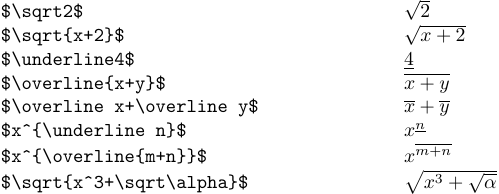3. Comandi in LaTeX
Un altro modo per costruire formule complesse da quelle semplici è usare i comandi \sqrt,\sottoline o \overline. Si applicano anche al carattere o alla sottomissione che li segue:

Puoi anche ottenere radici del cubo e cose simili:

These three commands place lines above and below subformulas of any size and shape; the bar lines change their size and position, so that they are long enough to cover the subformula, and high enough or low enough not to overlap with it. In particular, square root signs appear in a variety of positions depending on the height and depth of what’s being \sqrt‘ed:
 In such a case, you may want to typeset all square roots uniformly, like this:
In such a case, you may want to typeset all square roots uniformly, like this:
 The easy way to do this is to use the command
The easy way to do this is to use the command \mathstrut:
1$\sqrt{\mathstrut a} + \sqrt{\mathstrut d} + \sqrt{\mathstrut y}$.A \Mathstrut è una casella invisibile a larghezza zero. La sua altezza e profondità sono l’altezza e la profondità di una parentesi (. Ne consegue che le subformule che contengono \mathstrut avranno sempre la stessa altezza e profondità, a meno che non coinvolgano costruzioni più complicate come abbonamenti e sospetti.